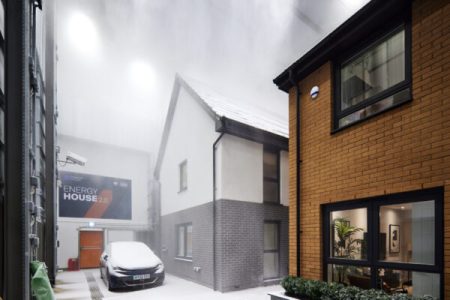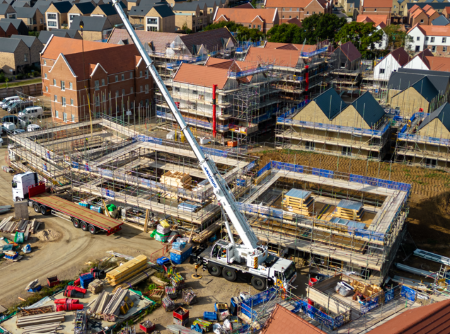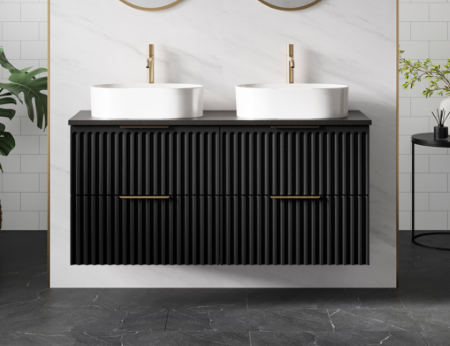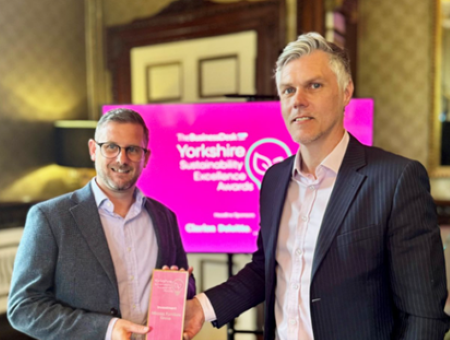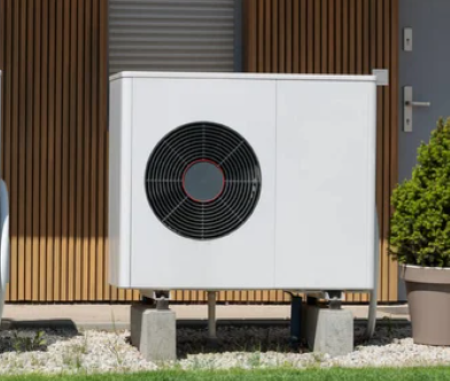Amid rising temperatures, water and fuel shortages, Barratt Developments has partnered with Saint-Gobain and the University of Salford to build a concept home that will test the effects of climate change and look at ways new houses can cope with more extreme weather conditions, whilst cutting energy and water usage.
Standing on the grounds of the University of Salford, the world-first Energy House 2.0 is a specially-built climate chamber that will recreate temperatures ranging from -20˚C to +40˚C, as well as simulating wind, rain, snow and solar radiation. The climate chamber is the largest of its kind in the world.
Inside Energy House 2.0, Barratt and Saint-Gobain, a building materials manufacturer, have built a three-bedroom family home – known as eHome2 – to test innovative building products designed to meet the Future Homes Standard. The house will also test zero carbon performance in different temperatures and weather conditions to replicate extreme changes in the climate.
The data will help to inform how the wider housebuilding sector can design homes that are future-proof, whilst cutting bills for consumers.
Oliver Novakovic, Technical and Innovation Director at Barratt, said: “As the leading national sustainable housebuilder, we’re building high-quality sustainable homes today, as well as innovating and adapting our designs for the future.
“Building eHome2 within the Energy House is one of the most significant projects that Barratt has ever undertaken. Along with Saint-Gobain and the University of Salford, we’re leading the way to test the impact that extreme temperatures caused by climate change could have.
“The 12-month project will inform us to build net zero housing at scale, using off-site methods of construction and lower carbon products that reduce the impact on the planet.”
The extreme heat seen this year has broken records around the world, bringing raging wildfires across Europe, Australia and the US. Large parts of the globe have suffered droughts over the past year, and three-quarters of the world is predicted by the UN to suffer regular droughts by 2050.
In the UK, we’ve experienced the 10 hottest years on record since 2002. The hottest-ever day – exceeding 40oC – was recorded this summer, leading to red weather warnings for heat. Parts of the country are expected to be in drought until the end of the year after the driest spring and summer in England since 1935.
Mike Chaldecott, CEO of Saint-Gobain UK & Ireland, said: “We’re delighted to be partnering with Barratt on this ground-breaking project. Climate change, water and resource scarcity are some of the most critical challenges of our time. Construction has to transform to meet these challenges.
“Creating eHome2 will create a new blueprint for building homes en-masse that are capable of operating at net zero carbon level, consuming far less water and creating less waste. At times like this, with the cost of energy is at a critical point, new solutions to create comfortable, efficient homes that will cost consumers far less to heat are essential.
The built environment accounts for 40% of the UK’s carbon footprint. Achieving the Government’s carbon reduction targets will require a step-change in the design of new homes. Barratt, Saint-Gobain and The University of Salford are working together to create a blueprint for future homes, including working in partnership to develop new low carbon products, such as the use of timber and render, instead of brick and block.
The Energy House is the next step from Barratt’s zero carbon concept home, known as Zed House, to integrate new and improved products and technologies into eHome2. Zed House, built in collaboration with the University of Salford and 40 innovation partners, reduced embodied carbon by 125%.
One of the advances that Barratt aims to make is to reduce water usage in eHome2 even further than in Zed House – where water was cut by over a quarter.
Significantly reducing water usage:
- Current UK Building Regulations state water usage of 125 litres, per person, per day
- Standard Barratt homes are designed to use 105 litres, per person, per day
- Zed House was designed to cut water usage to 90 litres, per person, per day
eHome2 is being built with an advanced timber frame solution, pre-insulated walls installed at the factory, and lightweight render-based bricks. The house will be built in 12-14 weeks – half the time it takes to build a standard home.
The £16m Energy House is part-funded by the European Regional Development Fund and harnesses the University of Salford’s expertise in climate and the built environment. This investment in Research & Development is designed to enable housebuilders across the UK to deliver the zero carbon homes the country needs, whilst reducing emissions and the impact of housebuilding on the climate.
Professor Will Swan, Director of Energy House Labs at the University of Salford said: “The growing challenges of climate change and the cost-of-living crisis mean we need to consider how we build and operate our homes. Energy House Labs’ mission is to work with industry and policy makers to provide evidence for what works in meeting these challenges.
“Energy efficient, high performing homes can change people’s lives. The importance of this agenda is one of the main reasons behind the University of Salford’s major investment in Energy House 2.0, which is a critical piece of research infrastructure that can help us find solutions to these problems.”
Richard Fitton, Professor in Building Performance at the University of Salford, said: “The development of EH2.0 has taken over six years and £16 million of funding.
“Our work with some of the largest house builders and product manufacturers in the UK will help to answer difficult questions about how we reach zero carbon target in future housing. The facility will help us to stress test these buildings under extreme hot and cold climates, to provide data on energy efficiency and overheating in homes.”
To read more news and exclusive features see our latest issue here
Never miss a story… Follow us on:
![]() Showhome
Showhome
![]() @Your_Show_Home
@Your_Show_Home
![]() @Showhomemag
@Showhomemag
Media Contact
Anna Wood
Editor, Showhome
Tel: +44 (0) 1622 823 922
Email: editor@yourshow-home.com

